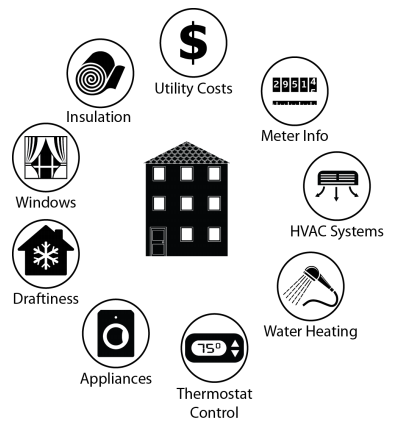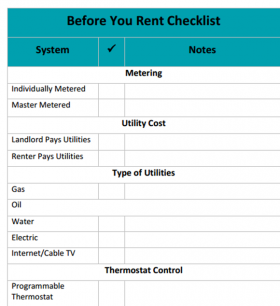By Charlie Taylor | Tue, January 19, 16
Rental horror stories, we’ve all got one. Whether it’s you or someone you know, it’s common to hear tales about moving into a new apartment or home and being caught off guard by some feature in the house that leads to skyrocketing energy costs or an uncomfortable living situation. Mine goes like this:
As I walk into a friend’s triple decker apartment building for the first time, I’m struck by how drafty the stairway feels. I shrug it off without mentioning anything; it’s winter after all. We make our way up to the top floor to check out the view of the city skyline from the roof when I notice there is no door to the roof deck, only a tarp draped over the door frame to give some false sense of security.
I had found the culprit of the drafty stairway. All of the heat in the house was rising up and out of this building like a big chimney, which was then pulling in cooler air from the outside. Cringing, I made my way down to my friend’s apartment and found that they had the windows opened in their living room. When I asked why, he responded that their landlord paid the gas bill and locked up the thermostat. It just got so hot in there that they had to leave a window open most of the time to make it tolerable. It’s easy to overlook energy waste like this in a situation where the landlord pays the energy bills, but the reality is the tenant is paying for it through increased rent.
Would knowing about these issues with the building before moving in affect a prospective tenant’s choice to live in this apartment? Probably not. But it could potentially initiate a conversation with the landlord about fixing them. An efficiently operated building can lead to lower rent when the landlord no longer has to charge as much to make up for the high energy bills. Tenants are typically surprised by problems like these after they’ve moved in, especially because the warning signs can be tough to spot. The attributes of a building that affect energy usage and comfort tend to be virtually invisible or, at the very least, difficult to see (except in the case of the missing door to the roof).

The Checklist
What if there was a way to make these aspects of a building visible to prospective tenants while they are touring apartments? NEEP’s “Guide for Renting and Creating Lower Cost, Energy Efficient Apartments and Homes” reveals some of the biggest sources of energy waste in multifamily buildings in a short checklist that can be referenced while touring a new potential home. Making this information accessible is a win for both the prospective tenant and real estate professionals. The tenant can ask informed questions regarding the aspects of the building that will affect their comfort levels, energy costs, and health while the real estate professionals get satisfied customers and higher referrals which leads to more business.
How Does it Work?
The checklist is broken up into nine different categories which affect the energy usage and safety of a home. Not sure what you’re looking for in any of these categories? Just find the corresponding section of the guide that provides background on the important factors contributing to energy usage and things to look out for. (See screenshot below) Bring the checklist to an apartment showing and go through each line as you tour the apartment or simply use it as a resource to prepare questions for your real estate professional before a showing.

How Will it Help Me?
Not everyone will be able to negotiate large energy efficiency retrofits with their landlord, but our guide also details strategies that are low or no-cost that also lead to energy savings and increased comfort, guiding renters through the important process of choosing a home that is comfortable, healthy, and affordable to live in.
So, if you’re ready to ditch the doors covered in tarp and the drafty stairwells, be sure to check out NEEP’s library of resources aimed at real estate professionals, home builders, and home buyers/renters aimed at transforming the market to properly value energy efficiency in real estate transactions.
